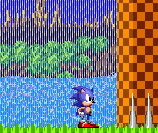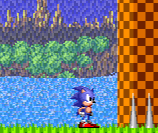Dithering is a process used by video game designers whereby thin interlocking strips of two different colours are added to the graphics. There are three main reasons for its use -
1. To allow more colours in a game than the hardware's natural limit.
2. To create new colours which aren't available in the hardware's colour pallet.
3. To give the appearance of transparencies for systems which do not have this feature as a hardware trait.
Dithering basically works because of the lower quality of older video cables, developers knew that if they put two thin strips of different colours next to each other the output would fuzz the two colours together to make a new colour, without this new colour standing against the hardware's actual colour limit.
So they would make their graphics look like this (this is a small section from The Lion King)

and the Television would output the image as this

With this method you've now got three colours onscreen for the price of two, not only that, but you've also got a smoother colour transition than would've normally been available.
The transparencies work in pretty much the same way except here the lines are meshed with the background graphics so that when they blur over, both elements are still visible.



There are unfortunately a few very major problems with dithering, the main issue of which being that it only really works with low end cables (coaxial or composite leads), and only with small to medium sized televisions. Better cables (such as S-Video or RGB) and emulators have good definition, so they clearly show the dithering in its original form as lines, removing the effect and causing the dithering to make the graphics look a little uglier when compared to games which don't use the effect.
The system which stands out most in my mind for its use of dithering is the Sega Mega Drive/Genesis, I think the main reason for this is due to the competition is faced from the SNES which had a much bigger colour pallet available and its own transparency features. Competing against the SNES probably pressurised Mega Drive video game designers to try to work out ways to equalise the SNES' impressive graphics.
The following screen shots are a selection of examples showing the difference between emulator shots and the sort of thing you would see coming from an actual television using the pack-in cables.